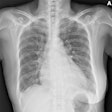Imaging facilities trying to reduce digital x-ray dose are turning to exposure index (EI) values to see how much radiation patients receive. New research indicates that while this is a good idea for digital radiography, it's not so hot for computed radiography (CR) due to wide variation in EI measures.
One of the most vexing problems in digital x-ray is exposure creep, when radiation dose slowly rises after radiography departments convert to digital. The phenomenon occurs because digital image processing can correct for overexposed images that might be unusable with analog radiography. This gives radiologists little indication that too much radiation was used.
Digital x-ray manufacturers have developed exposure index as a metric for measuring radiation dose to a digital detector and are displaying the value to clinicians. Many facilities have begun basing their digital x-ray quality assurance and dose reduction programs around EI values.
But exposure index has major drawbacks, especially with respect to computed radiography, according to a paper published online March 11 in Radiation Protection Dosimetry by researchers from Ireland and Australia. They found that CR systems produce a wide range of EI values for the same study on the same equipment, while digital radiography (DR) systems are uniformly consistent.
A research team led by Marie-Louise Butler of University College Dublin compared EI values produced by two CR systems (Agfa HealthCare, Mortsel, Belgium, and Carestream Health, Rochester, NY) and two DR systems (Siemens Healthcare, Erlangen, Germany, and Philips Healthcare, Andover, MA).
For each system, the researchers acquired 20 exposures each of four phantoms designed to represent different body regions: skull, chest, abdomen, and hand. They then compared the range of exposure index values produced for each of the 20 exposures.
For the DR units, the researchers found no change in EI values for any of the exposures. But for the CR systems, EI values varied widely, particularly for different anatomical regions. With the Agfa system, the highest logarithmic value (lGm -- Agfa's terms for exposure index) for skull exams indicated that for the highest exposure, twice the radiation dose was delivered to the phantom as the lowest exposure. For the Carestream unit, the highest EI value for chest exams was one-third higher than the lowest value.
According to the researchers, their study indicates that imaging facilities should be careful when relying on EI values in their dose-reduction and quality assurance programs.
"It is imperative that clinicians are aware of the fluctuations that are occurring in the EI value in CR systems outside of clinical conditions on which they have control," Butler and colleagues said. "The challenge is posed to the clinician to be able to assess the image quality outside of the EI value to ensure optimal clinical practice."
By Brian Casey
AuntMinnie.com staff writer
April 9, 2010
Related Reading
QA software automates CR reject analysis, December 23, 2009
Australian software automates data mining of CR dose, September 9, 2009
QA application can bolster DR image quality, consistency, December 22, 2008
Large CR study reveals wide variation in adult and pediatric protocols, September 3, 2008
PACS data-mining tool analyzes CR retake rates, August 5, 2008
Copyright © 2010 AuntMinnie.com



















